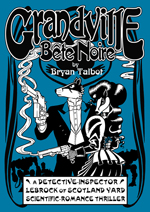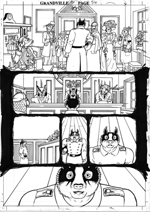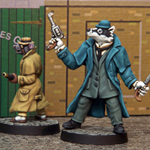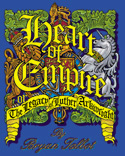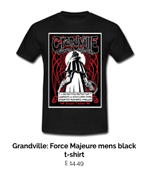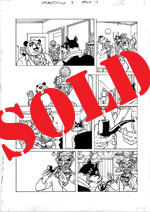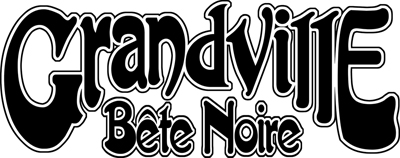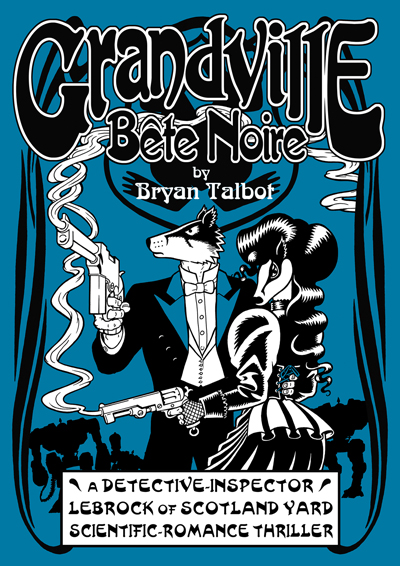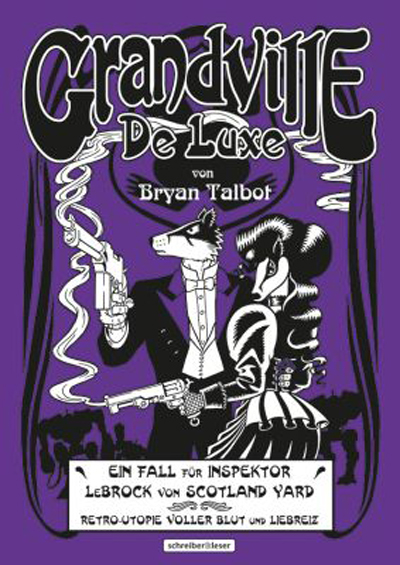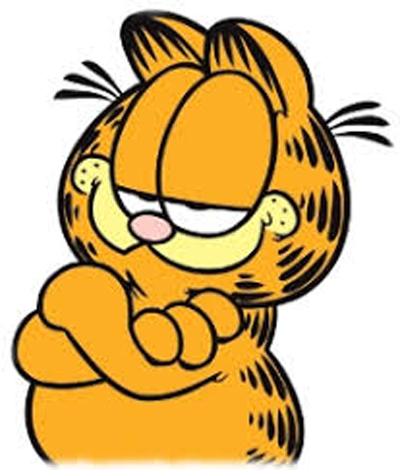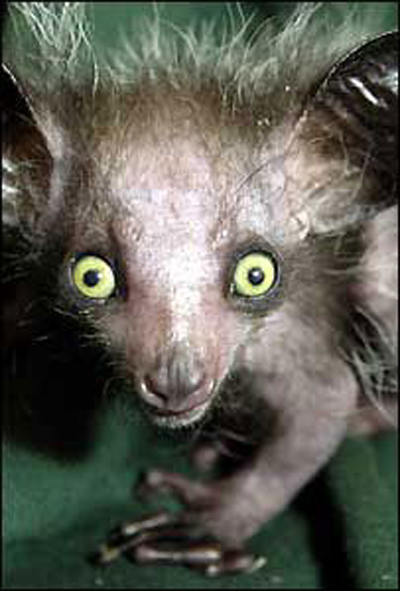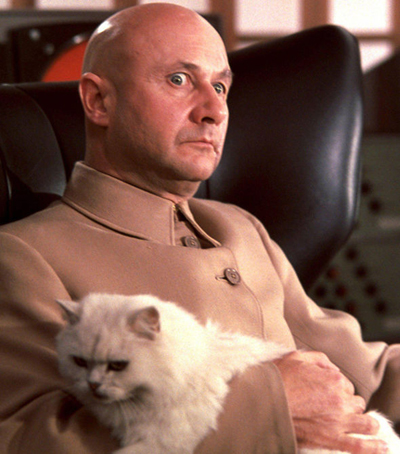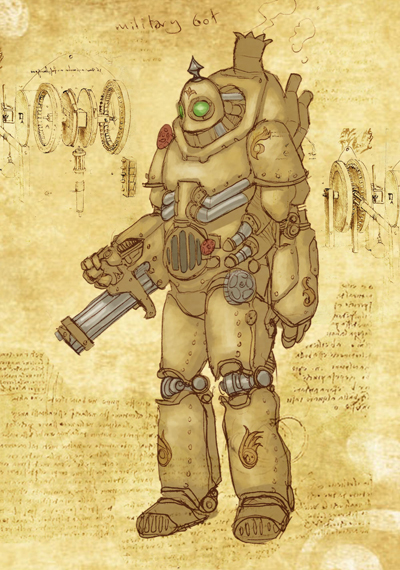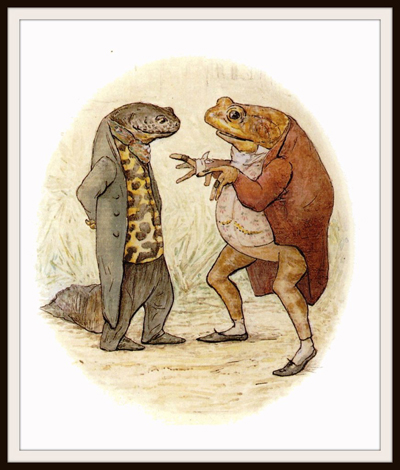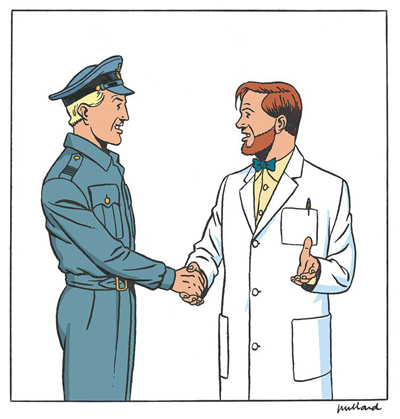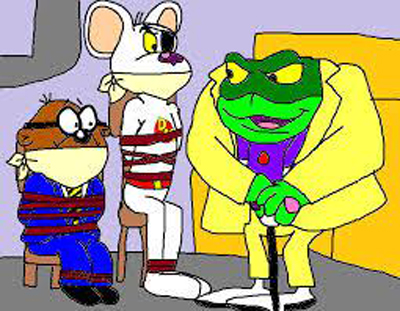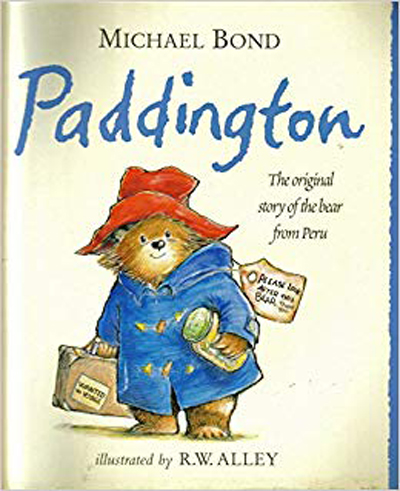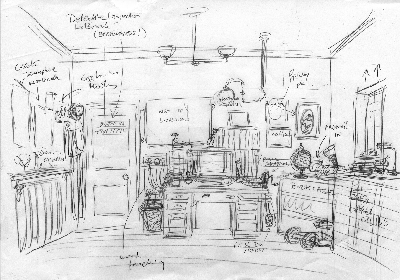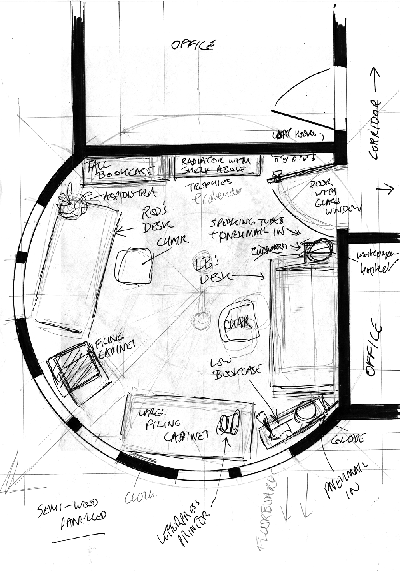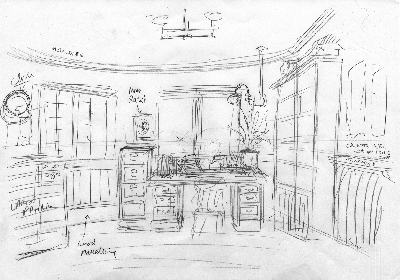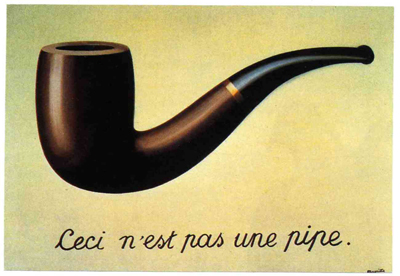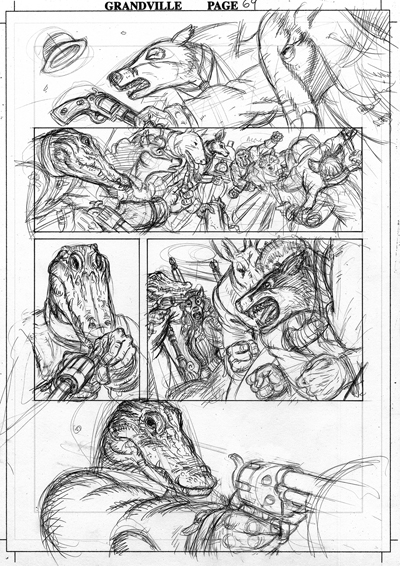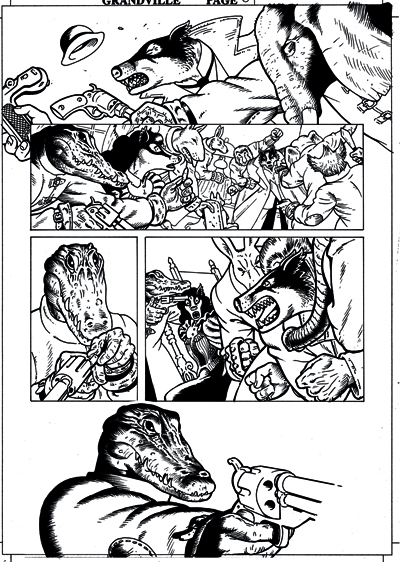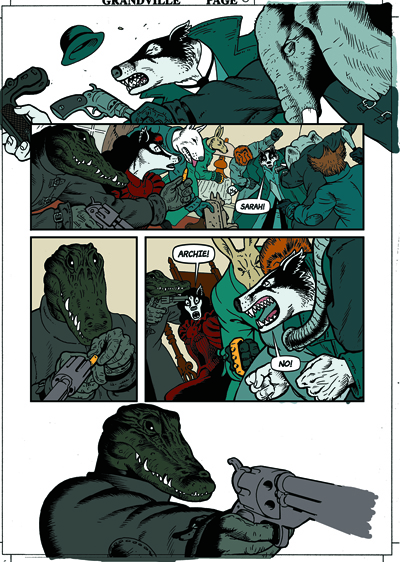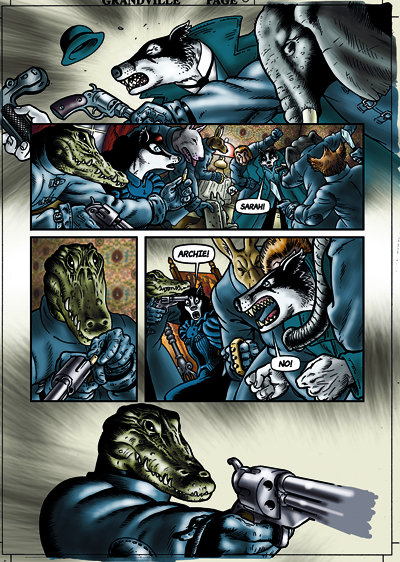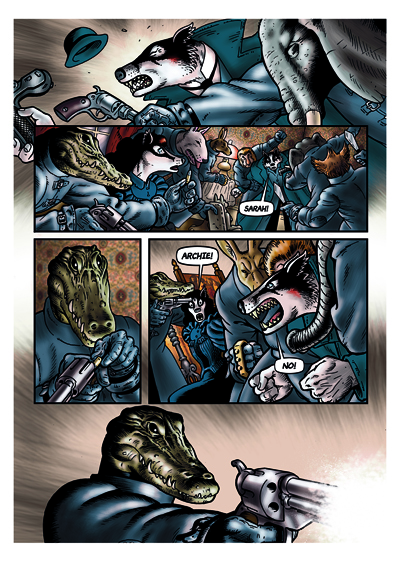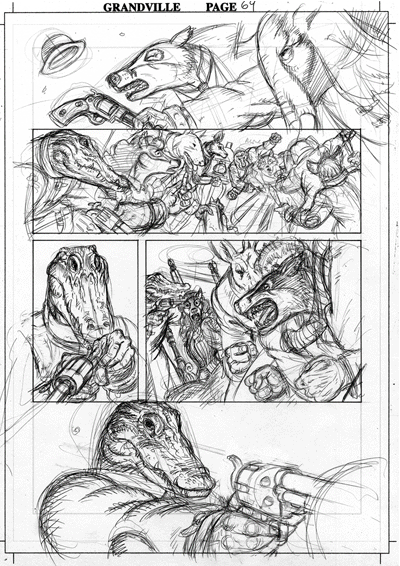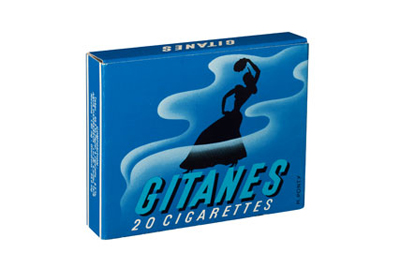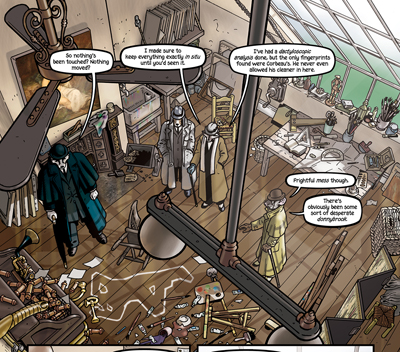Grandville Bête Noire annotations - page 1
This is similar in concept to the Directors Cut of Heart of Empire that Bryan and myself created: it is an attempt to answer the eternal "where do you get your ideas from?" question, and a way to showcase the influences and images that went into the creation of Grandville.
Below are the annotations for the Grandville Bête Noire pages 1 to 20: you can also jump to the annotations for pages 21 to 40, pages 41 to 60 and pages 61 to 65.
We are publishing updates to this page every Sunday and we will cover the entire Grandville series. Also see the annotations to the first Grandville graphic novel, and the second, Grandville Mon Amour.
Start reading the annotations below, or jump to page 1, page 2, page 3, page 4, page 5, page 6, page 8, page 11, page 12, page 13, page 14, page 15, page 17, page 18 and page 20.
Bête Noire: Fr. Literally “Black beast”: “A thing or person that is particularly disliked or feared. A personal bane or bugbear.”
Of course, Krapaud is a black beast.
Bête Noire isn’t commonly used in Germany, so Schrieber und Leser, the German publishers re-named it Grandville De Luxe.
If volume one was influenced by Quentin Tarantino and the second one Alfred Hitchcock, this third volume is most definitely the James Bond Grandville, as telegraphed by the front cover.
Page 1
While drawing these first 3 pages, I had lush John Barry James Bond incidental music going around my head.
Krapaud’s symbol: in folklore, a mythical jewel called a toadstone, or crawpock, or bufonite, is said to be found in the heads of toads, hence the diamond shape being part of the design.
Page 2
Naming Krapaud’s Bond-villian headquarters Toad Hall clearly indicates that the character is based on Toad from Kenneth Graham’s The Wind in the Willows. He really is an evil version of the rich, spoilt, egotistical Toad.
Page 3
You’ll notice that, among this collection of bankers and businessmen, there is a preponderance of literal fat cats, one of them Garfield, a strip whose style of whimsical humour leaves me cold.
I needed one of the characters to be a nervous type, so I made him a strange creature called an aye-aye, as they seem to look perpetually nervous. This is one of the advantages of an anthropomorphic story: you can indicate character by the choice of animal, a little like the use of masks in some forms of theatre, such as the Italian Commedia dell’arte or Japanese Noh Theatre.
Panel 6
“Patriotic duty”: Often used to disguise self-interest.
“Patriotism is the last refuge of a scoundrel.”
Samuel Johnson (1709 – 1784)
Page 4
Panel 1
My depiction of Aristotle Krapaud here (Krapaud: Fr. “Crapaud”: “toad”) is definitely referencing the famous Bond villain Ernst Stavro Blofeld, who’s usually seen stroking his cat. He appears in several of the novels and films. Here’s Donald Pleasance in the role.
Crooked Dice have also just produced a Krapud figurine. Here it is, minus his railchair, which hasn’t been painted yet. As soon as it is, we’ll update this image.
Panel 3
The design of Krupp’s automatons is partly inspired by this sketch by my son Alwyn, a brilliant illustrator and computer-game concept artist.
Page 5
Panel 2
Triton: Fr. “Newt”.
Panel 3
Krupp’s sister dies at the end of Grandville, both named after the famous German arms manufacturer. I also had a character named Krupp in The Adventures of Luther Arkwright. Using animals as characters mean that you can always play against type. As in the case of using a wombat to portray an arms dealer.
Panel 4
“Isaac”: named after the Beatrix Potter character Sir Isaac Newton from The Tale of Jeremy Fisher.
Page 6
Isaac being drunk all the time is an allusion to a phrase familiar with British readers, but not to others. Being drunk: being “pissed as a newt”.
Panel 4
The character Angus Mortimire is a homage to famous Belgian BD character Philip Mortimer from the series Blake and Mortimer by Edward P Jacobs.
Page 8
Panel 3
While drawing the book and showing the work-in-progress at conventions, several people assumed that Krapaud was a reference to Baron Greenback, a character in the Cosgrove Hall TV series Danger Mouse. I’ve never actually seen the series, but thought that the mention of a “Greenback Suite” would amuse old Danger Mouse fans.
Panel 6 & 7
“The most important person in the world…myself.” This just about sums up the attitude of Toad in Wind in the Willows.
Page 11
“Cour d’Ecosse”: Fr. Scotland Yard
This was the old “New Scotland Yard” building on Thames Embankment, from 1890 to 1967, before the police headquarters moved to Victoria. Three years after Bête Noire was published, it moved again, back to the Embankment to a new building, next door to this one.
In the background, we can see a grown-up, inebriated Paddington Bear. Of course, since then, Michael Bond’s famous children’s character has become a movie star.
Page 12
Thought you’d like to see the plan I made of LeBrock’s office, and the two very rough quick sketches I made of the north and south walls before embarking upon drawing this scene, so I knew what the room looked like from every angle.
LeBrock's office - north wall.
Plan of LeBrock's office
LeBrock's office - south wall.
Panels 1 & 2
LeBrock’s non-verbal code does indeed come in useful in Grandville Force Majeure and was deliberately planted here for that reason.
Page 13
Panel 2
Stoatson is first mentioned in Mon Amour, then here and in the next book, but we only finally meet him in Force Majeure.
Panel 3
Professor Quimby Quayle: an obvious reference to Q in the James Bond stories. Named “Quimby” after Fred Quimby, producer of the Tom and Jerry cartoons.
Panel 6
This panel references the famous painting by Belgian surrealist René Magritte, The Treachery of Images, sometime known as Ceci n’est pas un pipe (“This is not a pipe”). The meaning is that it’s not a pipe but a representation of one.
Panel 7
Vitriol is an old-fashioned word for sulphuric acid.
This explanation of how the bomb would work was formulated for this book by award-winning Canadian colourist and writer Lovern Kindzierski, whose daughter Jesse did the colour flats for much of the Grandville series.
Perhaps this would be a good place to talk about the colour process. The following is part of a piece I wrote for the French edition of Grandville.
Although the vast majority of the artwork in the book is created traditionally, it is coloured and finished on computer using Photoshop. Let’s look at a sample page – actually the only page that I scanned the pencils for, for a comics fanzine. Here’s the drawing, done with a pencil on a drawing board, for page sixty-nine of Grandville.
This was then inked, using a brush and technical pens, then the pencil lines were erased with a rubber. This is the point when I scanned the page into the computer and cleaned up any unwanted marks and made any corrections to the linework using the Photoshop eraser and brush tools.
Next were the colour flats: the different areas of the illustrations were selected and filled with different solid colours on a layer beneath the linework. About three quarters of the colour flats in the book were done by my friend, the designer Jordan Smith. Creating a graphic novel is a long slog and anything that can save me time is a bonus. You can see that I’ve also added the final panel borders using the line tool and the text and speech balloons, both on separate layers above the ink line layer.
Having flats means that I could select each area easily using the magic wand tool. I then adjusted the colours and rendered them in a way that’s very similar to painting, working on a Wacom tablet and mainly using the dodge and burn tools and the airbrush to create light, shade and texture. I also dropped in the wallpaper and screen designs in the backgrounds of panels two, three and four.
And this is the finished page. I’ve added a pale red tint on a multiply layer, as on all the pages in this apartment scene, to give it its own atmosphere, adding highlights by rubbing out parts of the layer with the eraser tool. I usually give each scene a different colour tint. I then added the gun flash on a layer above the rest using a mixture of the airbrush tool and some scanned-in ink splatter, reversed from black to white. The overlap, or “bleed” around the sides, to prevent a white line appearing if it is printed slightly off centre disappears in the printing process.
And here is the same set of images in the page creation process, all animated into a single sequence.
Page 14
Panel 1
WD & HO Wills is a now defunct British tobacco importer and manufacturer. “Shag” is the term for loose tobacco sold for pipes and hand-rolled cigarettes.
Panel 3 & 7
On the wall is a picture of LeBrock’s mentor, Stamford Hawksmoor. We finally meet him in Force Majeure, along with Kray, mentioned here and again on page 66.
Page 15
Panel 1 & 2
In the background, we can see trophies illustrating LeBrock’s prowess as a fencer, boxer, archer and marksman.
Panel 4
“Gipsy Woman” in French is “Gitane”. Gitanes is a famous brand of French cigarettes that had a beautiful art deco illustration of a dancing gipsy woman on its packets, and I think still has.
Panel 5
“Jules”: This is the first time we’ve heard Chief-Inspector Rocher’s forename. He’s named after Georges Simenon’ famous French detective Commissaire Jules Maigret.
Panel 6
Gustave Corbeau: Corbeau Fr. “crow” or “raven”. A play of the name of French 19th century painter Gustave Courbet.
Page 17
Panel 1
Histrionicotoxin: This is indeed a yellow poison made from equatorial South American frog skin extract.
Page 18
As I’ve previously stated, the Grandville series is my homage to the detective story genre, and this volume is no exception. I’d already tackled the conspiracy and serial-killer scenarios and here I wanted to do a genuine locked-room mystery.
To quote Wikipedia: “The "locked-room", or "impossible crime" mystery is a subgenre of detective fiction in which a crime (almost always murder) is committed in circumstances under which it was seemingly impossible for the perpetrator to commit the crime or evade detection in the course of getting in and out of the crime scene. The crime in question typically involves a crime scene with no indication as to how the intruder could have entered or left, i.e., a locked room. Following other conventions of classic detective fiction, the reader is normally presented with the puzzle and all of the clues, and is encouraged to solve the mystery before the solution is revealed in a dramatic climax.
To investigators of the crime, the prima facie impression almost invariably is that the perpetrator has vanished into thin air. The need for a rational explanation for the crime is what drives the protagonist to look beyond these appearances and solve the puzzle."
The Wikipedia entry also boasts a good history of the sub-genre.
I referenced the locked room mystery in the first volume but, as LeBrock solves it immediately, didn’t think it counted, so here’s the proper job. There have been thousands of variations, but I think that this is definitely the first time the cause of death is murder by pneumail!
Dactyloscopy: the science of fingerprint identification.
Page 20
Panel 4
“Who’d have thought a place like that could be used to display art?”: The railway station Gare d’Orsay, as seen in Mon Amour, is now the Musée d’Orsay, containing the largest collection of impressionist and post-impressionist masterpieces in the world. Well worth a visit.
Panel 5
Auguste Rodent: named after the French sculptor and painter Auguste Rodin (1840 – 1917)
Panel 6
The Giraud School of Art: Named after French bande dessinée artist Jean Giraud (1938 -2012), perhaps better known by his pseudonym Moebius.
Also see the annotations for Grandville Bête Noire pages 21 to 40.

